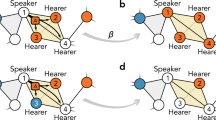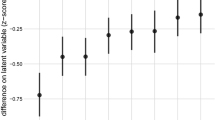Abstract
As the diversity of people in higher education grows, universities are struggling to provide inclusive environments that nurture the spirit of free inquiry in the presence of these differences. Throughout my career as an astronomer, I have witnessed these struggles first-hand. Exclusive cultures result in unfulfilled potential of all members of the institution — students, administrators and faculty alike. This Perspective draws on insights from dynamical systems descriptions of conflict developed in the social and behavioural sciences to present a model that captures the convoluted, interacting challenges that stifle progress on this problem. This description of complexity explains the persistence of exclusive cultures and the inadequacy of simple fixes. It also motivates the necessity of prolonged and multifaceted approaches to solutions. It is incumbent on our faculties to recognize the complexities in both problems and solutions, and persevere in responding to these intractable dynamics, on our administrations to provide the consistent structure that supports these tasks, and on all of our constituents to be cognizant of and responsive to these efforts.
This is a preview of subscription content, access via your institution
Access options
Access Nature and 54 other Nature Portfolio journals
Get Nature+, our best-value online-access subscription
$29.99 / 30 days
cancel any time
Subscribe to this journal
Receive 12 digital issues and online access to articles
$119.00 per year
only $9.92 per issue
Buy this article
- Purchase on Springer Link
- Instant access to full article PDF
Prices may be subject to local taxes which are calculated during checkout

NASA, ESA, and the Hubble Heritage Team (STScI/AURA)




Similar content being viewed by others
References
Mulvey, P. J. & Nicholson, S. Focus on Trends in Physics PhDs Technical Report (American Institute of Physics, Statistical Research Center, 2014); https://www.aip.org/statistics/reports/.
McIntosh, P. in The Teacher in American Society: A Critical Anthology (ed. Provenzo, E. F.) 121–134 (Sage, 2010).
Miller, C. W., Zwickl, B. M., Posselt, J. R., Silvestrini, R. T. & Hodapp, T. Typical physics Ph.D. admissions criteria limit access to underrepresented groups but fail to predict doctoral completion. Sci. Adv. 5, eaat7550 (2019).
Phillips, K. W. How diversity works. Sci. Am. 311, 42–47 (2014).
Sheridan, J. et al. Write more articles, get more grants: the impact of department climate on faculty research productivity. J. Womens Health 26, 587–596 (2017).
Spradlin, D. Are you solving the right problem?. Harv. Bus. Rev. 90, 84–93 (2012).
Coleman, P. et al. Promoting constructive multicultural attractors: fostering unity and fairness from diversity and conflict. J. Appl. Behav. Sci. 53, 1–32 (2017).
Prescod-Weinstein, C. Curiosity and the end of discrimination. Nat. Astron. 1, 0145 (2017).
Porter, A. M. & Ivie, R. Women in Physics and Astronomy, 2019 Technical Report (American Institute of Physics, Statistical Research Center, 2019); https://www.aip.org/statistics/reports/
Goulden, M., Mason, M. A. & Frasch, K. Keeping women in the science pipeline. Ann. Am. Acad. Pol. Soc. Sci. 638, 141–162 (2011).
Stewart, A. J. & Valian, V. An Inclusive Academy (MIT Press, 2018).
Wilkins, L. & Kaiser, C. Racial progress as threat to the status hierarchy: implications for perceptions of anti-white bias. Psychol. Sci. 25, 439–446 (2014).
Craig, M. & Richeson, J. A. On the precipice of a “majority–minority” America: perceived status threat from the racial demographic shift affects white Americans’ political ideology. Psychol. Sci. 25, 1189–1197 (2014).
Sue, D. Race talk: the psychology of racial dialogues. Am. Psychol. 68, 663–672 (2013).
Dobbin, F. & Kalev, A. Why diversity training doesn’t work: the challenge for industry and academia. Anthropol. Now. 10, 48–55 (2018).
O’Meara, K., Kuvaeva, A. & Nyunt, G. Constrained choices: a view of campus service inequality from annual faculty reports. J. High. Educ. 88, 672–700 (2017).
Hekman, D. R., Johnson, S. K., Foo, M.-D. & Yang, W. Does diversity-valuing behavior result in diminished performance ratings for non-white and female leaders? Acad. Manage. J. 60, https://doi.org/10.5465/amj.2014.0538 (2016).
Johnson, S. K. & Hekman, D. R. Women and minorities penalized for promoting diversity. Harv. Bus. Rev. https://hbr.org/2016/03/women-and-minorities-are-penalized-for-promoting-diversity (2016).
Yen, J. A case study on debiasing a postdoctoral fellowship evaluation process: six strategies for in-person review panels. Nat. Astron. https://doi.org/10.1038/s41550-019-0835-7 (2019).
Reid, I. Gender-correlated systematics in HST proposal selection. Publ. Astron. Soc. Pac. 126, 923–934 (2014).
Strolger, L. & Natarajan, P. Doling out Hubble time with dual-anonymous evaluation. Physics Today https://doi.org/10.1063/PT.6.3.20190301a (2019).
Levesque, E. M., Bezanson, R. & Tremblay, G. R. Physics GRE scores of prize postdoctoral fellows in astronomy. Preprint at https://arxiv.org/abs/1512.03709 (2015).
Galinsky, A. D. et al. Maximizing the gains and minimizing the pains of diversity: a policy perspective. Perspect. Psychol. Sci. 10, 742–748 (2015).
Policy and Planning Committee Equity Reports: Natural Sciences, Humanities, Social Science Technical Report (Columbia Univ., 2018); https://fas.columbia.edu/files/fas/content/Columbia-ArtsandSciences-PPC-Equity-Reports-2018.pdf
Belle, D., Smith-Doerr, L. & O’Brien, L. M. in Gender Transformation in the Academy (eds Demos, V. et al.) 153–175 (Emerald Group Publishing, 2014).
Banaji, M. & Greenwald, A. Blind Spot: Hidden Biases of Good People (Delacorte Press, 2013).
Wenneras, C. & Wold, A. Nepotism and sexism in peer review. Nature 387, 341–343 (1997).
Trix, F. & Psenka, C. Exploring the color of glass: letters of recommendation for female and male medical faculty. Discourse Soc. 14, 191–220 (2003).
Budden, A. E. et al. Double-blind review favours increased representation of female authors. Trends Ecol. Evol. 33, 4–6 (2008).
Neureiter, M. & Traut-Mattausch, E. An inner barrier to career development: preconditions of the impostor phenomenon and consequences for career development. Front. Psychol. 7, 48 (2016).
Steele, C. M. & Aronson, J. Stereotype threat and the intellectual test performance of African Americans. J. Pers. Soc. Psychol. 69, 797–811 (1995).
Steele, C. Whistling Vivaldi (W. W. Norton, 2011).
Acknowledgements
I acknowledge support from National Science Foundation (NSF) grant AST-1715582. I am grateful for the hospitality of the Kavli Institute for Theoretical Physics (supported by NSF grant PHY-1748958) and the University of California at Santa Cruz during my sabbatical. I thank my fellow members of Columbia’s Committee on Equity and Diversity, colleagues in astronomy (S. Hawley, S. Ho, D. Hogg, J. Holbrook, J. Kollmeier, A. Shapley, R. Somerville and D. Spergel) and beyond (P. Coleman, G. Justice, C. Kaiser and D. Kardia), and friends in the PDPG for feedback as the discussion in this paper was being developed. I thank B. Starling for reading and re-writing.
Author information
Authors and Affiliations
Corresponding author
Ethics declarations
Competing interests
The author declares no competing interests.
Additional information
Peer review information Nature Astronomy thanks Kim Coble and Laura Kramer for their contribution to the peer review of this work.
Publisher’s note Springer Nature remains neutral with regard to jurisdictional claims in published maps and institutional affiliations.
Rights and permissions
About this article
Cite this article
Johnston, K.V. A dynamical systems description of privilege, power and leadership in academia. Nat Astron 3, 1060–1066 (2019). https://doi.org/10.1038/s41550-019-0961-2
Received:
Accepted:
Published:
Issue Date:
DOI: https://doi.org/10.1038/s41550-019-0961-2
This article is cited by
-
Elevate, don’t assimilate, to revolutionize the experience of scientists who are Black, Indigenous and people of colour
Nature Ecology & Evolution (2020)



